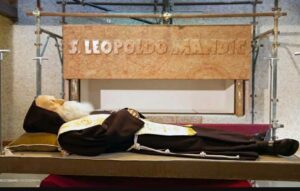About Saint Leopold Mandić:
Born on May 12, 1866 in Croatia, Leopold was an unlikely candidate for the priesthood: he had several health problems, could not speak loudly enough to preach and had poor eyesight (how often do we hear of such people going on to become saints? God makes fools out of the wise, for sure) Leopold joined the Capuchin Franciscans and was ordained several years later. He was assigned to Padua, where he spent the rest of his life.
For several years Leopold taught patrology, the study of the Church Fathers, to the clerics of his province, but he is best known for his work in the confessional, where, like Saint Padre Pio and Saint John Vianney, he sometimes spent 13-15 hours a day. In addition to laity and priests, everal bishops sought out his spiritual advice.
Leopold’s dream was to go to the Orthodox Christians and work for the reunion of Roman Catholicism and Orthodoxy. His health never permitted it.
At a time when Pope Pius XII said that the greatest sin of our time is “to have lost all sense of sin,” Leopold had a profound sense of sin and an even firmer sense of God’s grace awaiting human cooperation.
Leopold, who lived most of his life in Padua, died on July 30, 1942, and was canonized in 1982. We celebrate the Feast Day of Saint Leopold Mandić on May 12.
At the personal request of Pope Francis, Saint Leopold’s Mandić’s body was brought to Rome for veneration during the 2015–2016 Extraordinary Jubilee of Mercy, along with his fellow Capuchin friar, Padre Pio of Pietrelcina. They were designated as saint-confessors to inspire people to become reconciled to the Church and to God, by the confession of their sins. Their bodies were available for veneration, first at the Basilica of Saint Lawrence outside the Walls (which is administered by the Capuchin friars) and then at St. Peter’s Basilica. The Saints’ body has also been displayed in Zagreb and Dubrovnik, Croatia.
Interesting note: if you visit Medjugorje, you will find a large statue of Saint Leopold located (fittingly) next to the outdoor confessionals. This seems appropriate since Medjugorje is under the auspices of the Franciscans and Saint Leopold was from this area.
About the Sanctuary of St. Leopold Mandić in Padua:
The church of the Capuchin friars of Padua, now better known as the Sanctuary of St. Leopold Mandić, was built in the 16th century. Almost completely destroyed in World War II, it was later rebuilt. Its interior is rich with interesting canvases of the sixteenth and seventeenth centuries.
The tomb of St. Leopold, is located in a chamber adjacent to the church, near the little room in which the saint heard confessions.
The chapel and the tomb of the saint:

To the front of the confessional cell of St. Leopold is the chapel where, since 1963, the body of the saint has rested. The red marble tomb is visited by an endless stream of pilgrims, attracted by the spiritual strength of a friend who continues to protect and comfort. Inside the chapel, next to the memorial plaque, is a niche in which a reliquary of the right hand of the saint is displayed, to recall the countless occasions on which he raised this hand to absolve, bless or console.
The painted altarpiece of the chapel, the work of Lino Dinetto, depicts St. Leopold’s mission of bringing souls to the Holy Trinity, through the mediation of Jesus the Redeemer. The priest’s stole and the Franciscan habit worn by St. Leopold recall his service and the gift of his entire existence: the confessor saint is depicted on his knees as intercessor and as a brother who points out the road that leads to intimacy with Christ. On the exterior, above the tomb, the “Light of Reconciliation” burns day and night.
The rite of offering of the oil that keeps it burning is renewed every year on May 12, the liturgical feast of the saint.
The confession room:
Here, for around 33 years, St. Leopold passed most of his day in hearing the faithful, administering the Sacrament of Reconciliation and in silent prayer. It is a small space which has remained as it was from the saint’s time. There is a little chair in which the confessor sat, a kneeler for the penitent, and a cross hanging on the wall, before which pilgrims and the devout kneel in prayer.
The faithful continue to leave notes, prayers and thanks on the pages of a large volume placed on a lectern. In one of these volumes, on September 12, 1982, Pope John Paul II wrote his signature, after having stayed a while in this room in prayer.
Other original furnishings from this room, along with other articles that belonged to the saint, are displayed in two small adjoining rooms. A plaque on the exterior wall records how during the bombardment of 14th May 1944 the confession room was miraculously preserved, as the saint had predicted: “it will survive as a monument to divine mercy”.
Finding the Sanctuary of St. Leopold Mandić in Padua:
Address: Piazzale S. Croce, 44, Padua, PD, 35123 ITALY
Tel: +39 049.8802727
Click here for the official website of the Sanctuary of St. Leopold Mandić in Padua.

